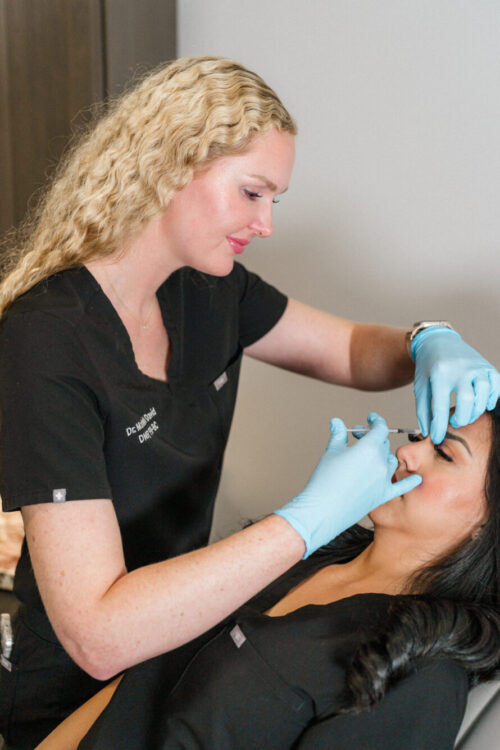

Dysport®
in Northern VirginiaDysport®
Tox alternative
AVERAGE COST: $200 – $600
Dysport® is a derma injectable comparable to BOTOX that is added into the skin to ease the underlying muscles so that the skin appears relaxed.
DYSPORT® OVERVIEW
When Dysport® is injected into a patient’s face by one of our team members at Mountcastle Plastic Surgery, the muscles under the skin relax, and the visible wrinkles on the outer layer of the skin soften. Known medically as abobotulinum toxin A, it offers many of the same benefits as BOTOX®, with subtle differences. Dysport® is a drug that helps reduce frown lines and wrinkles in the upper face, and it blocks the actions of acetylcholine, a neurotransmitter in the nervous system. Some practitioners like Dr. Mountcastle, use Dysport® and BOTOX® interchangeably, selecting BOTOX® for the forehead while using Dysport around the eyes. Dysport® has shown to act quicker than BOTOX, and it also diffuses further from the injection site offering a greater spread.

ADMINISTERING DYSPORT
Dysport is injected via a fine needle to specific areas on the face. Prior to the injection, these areas are marked, and a numbing anesthetic is applied. The amount of medicine injected varies by patient depending on their aesthetic goals. Some individuals will have deeper, broader wrinkles while others wish to target fines lines (which requires less product). Dysport is administered during an in-office appointment that typically lasts about 30 minutes.
WHAT TO EXPECT?
There is no downtime after a Dysport injection. Some mild swelling and redness may occur at the injection sites, but the skin will return to a normal appearance a few hours after treatment. Ice packs are often compressed to the site immediately after treatment to help calm the skin and reduce these after-effects. Patients are able to resume their normal activities on the same day as their treatment. Results will become apparent within a couple of short days.

DYSPORT® FAQS
-
Both Botox and Dysport are FDA-approved neuromodulators made from botulinum toxin type A, and they work in the same way — by temporarily relaxing muscles to soften lines and wrinkles.
But there are subtle differences:
Comparison at a Glance
Feature Botox Dysport Molecule Size Larger molecules Smaller, more diffuse molecules Onset Time 3–5 days to start seeing results 1–3 days to start seeing results Duration 3–4 months 3–4 months (varies slightly) Best For Small, targeted areas like crow’s feet or glabella lines Larger areas like the forehead or masseters Units Needed Fewer units (more concentrated) More units (but usually priced to match)
So… which is better?
It depends on your goals and your anatomy. Here’s how we guide patients at Mountcastle Medical Spa & Laser Center:
-
Choose Botox if: you’re new to neuromodulators, want extremely precise placement, or are treating small areas.
-
Choose Dysport if: you’re treating broader areas like the forehead or want results to kick in a bit faster.
Pro Tip:
Some patients respond slightly better to one over the other — it’s not uncommon to try both and see which lasts longer or looks more natural for you.
Ready to Try It?
Book your consultation with one of our expert injectors here or call us at 571-266-1776. We’ll assess your facial anatomy and customize a treatment plan using Botox, Dysport, or both depending on what suits you best!
Want a visual of the difference in results? Check out our Botox & Dysport transformations on Instagram.
-
-
Patients seeking to rejuvenate their facial appearance may look into injectable fillers, as well as products such as Dysport® to attain results. Both skin treatments work to decrease facial wrinkles but use varying approaches. Injectable fillers add volume to certain facial structures, which creates a smooth result on the surface. It is common today to combine products such as Dysport® and BOTOX®, with an injectable filler. This has been labeled a “liquid facelift” and provides outstanding results for individuals who do not want surgery.
-
Patients are usually ready for a follow-up visit within 3-4 months after treatment. This varies by patient.
